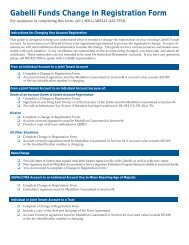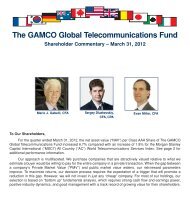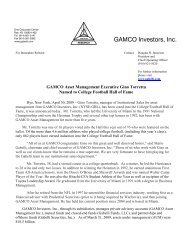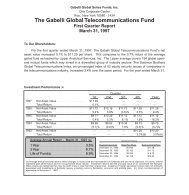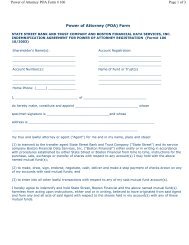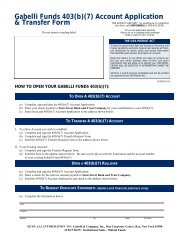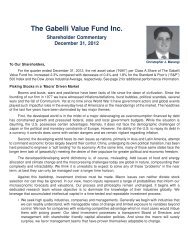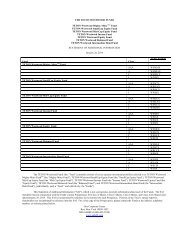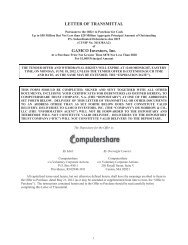FORM 10-K/A GAMCO Investors, Inc. - Gabelli
FORM 10-K/A GAMCO Investors, Inc. - Gabelli
FORM 10-K/A GAMCO Investors, Inc. - Gabelli
- No tags were found...
Create successful ePaper yourself
Turn your PDF publications into a flip-book with our unique Google optimized e-Paper software.
Diluted net income per share, in addition to the weighted average number of shares determined for basic net income per share, includes common stock equivalents which would<br />
arise from the exercise of stock options using the treasury stock method and, if dilutive, assumes the conversion of our convertible note for the period outstanding since its issuance<br />
in August 2001. An average of 208,000, 151,000 and 29,000 incremental shares were included as the dilutive effect of stock options in 2004, 2005 and 2006, respectively. In<br />
2004, net income is adjusted for interest expense, net of management fees and taxes, of $2,862,000 and the weighted average shares outstanding includes 1,923,000 incremental<br />
shares as the convertible note had a dilutive effect. In 2005, net income is adjusted for interest expense, net of management fees and taxes, of $1,758,000 and the weighted<br />
average shares outstanding includes 1,199,000 incremental shares as the convertible note had a dilutive effect. In 2006, net income is adjusted for interest expense, net of<br />
management fees and taxes, of $1,489,000 and the weighted average shares outstanding includes 956,000 incremental shares as the convertible note had a dilutive effect.<br />
Stock Based Compensation<br />
We currently sponsor stock option plans previously adopted and approved by our shareholders as a means to attract, retain and motivate employees. Effective January 1, 2003, we<br />
adopted the fair value recognition provisions of SFAS No. 123 “Accounting for Stock-Based Compensation” in accordance with the transition and disclosure provisions under the<br />
recently issued SFAS No. 148, “Accounting for Stock-Based Compensation – Transition and Disclosure.” Previously we had elected to use the intrinsic value method prescribed<br />
in Accounting Principles Board (“APB”) Opinion No. 25, “Accounting for Stock Issued to Employees” and related interpretations. Accordingly, no compensation expense was<br />
recognized where the exercise price equaled or exceeded the market price of the underlying stock on the date of grant. We adopted Statement 123 (R) “Share-Based<br />
Payment” (“Statement 123 (R)”) on January 1, 2005. In light of our modified prospective adoption of the fair value recognition provisions of Statement 123 (R) for all grants of<br />
employee stock options, the adoption of Statement 123 (R) did not have a material impact on our consolidated financial statements. In 2004, 2005 and 2006, we have recognized<br />
a total of $1,819,000, $2,770,000 and $53,000, respectively, in option expense. We expense stock option compensation over the vesting period of the option in line with the<br />
vesting characteristics. Refer also to Note F.<br />
Business Segments<br />
We operate predominantly in one business segment, the investment advisory and asset management business. We conduct our investment advisory business principally through:<br />
<strong>GAMCO</strong> (Separate Accounts), Funds Advisor (Mutual Funds) and GSI (Investment Partnerships). We also act as an underwriter, are a distributor of our open-end mutual funds<br />
and provide institutional research through <strong>Gabelli</strong> & Company, our broker-dealer subsidiary.<br />
Reclassifications<br />
Certain prior period amounts reflect reclassifications to conform with the current year’s presentation.<br />
Changes in Accounting Policy<br />
GBL has voluntarily changed its accounting method to recognize management fee revenues on closed-end preferred shares at the end of the measurement period, effective January<br />
1, 2006. Unlike most money management firms, GBL does not charge fees on leverage in its closed-end funds unless the total return to the common shareholders (of the closedend<br />
fund at year-end) exceeds the dividend rate of the preferred shares. Prior to the accounting change, GBL recognized these revenues during each interim reporting period if and<br />
when the total return to common shareholders of the closed-end fund exceeded the dividend rate of the preferred shares. Under this method, management fee revenues recognized<br />
in prior interim periods during the measurement period were subject to possible reversal in subsequent periods during that measurement period. This change in method had no<br />
impact on full year net income as the measurement date is the same as the fiscal year end.<br />
In addition, GBL has changed its accounting method to recognize incentive allocation or fee revenues on investment partnerships at the end of the measurement period, effective<br />
January 1, 2006. Prior to the accounting change, GBL recognized these revenues during each interim reporting period. Under this method, incentive fee revenues recognized in<br />
prior interim periods during the measurement period were subject to possible reversal in subsequent periods during the measurement period. Had this method not changed, we<br />
would have recorded approximately $0.2 million less in incentive fee revenues on investment partnerships for the year ended December 31, 2006.<br />
After considering the guidance provided in EITF D-96, “Accounting for Management Fees Based on a Formula”, GBL believes that the preferable method of accounting is to<br />
recognize management fee revenues on closed-end preferred shares and incentive fees on investment partnerships at the end of the measurement period. This method results in<br />
revenue recognition only when the measurement period has been completed and when the management fees and incentive fees have been earned. This eliminates the possibility of<br />
revenues that have been recognized in interim measurement periods subsequently being reversed in later periods during a fiscal year.<br />
Under SFAS No. 154 “Accounting Changes and Error Corrections,” which GBL adopted on January 1, 2006, a voluntary change in accounting principle requires retrospective<br />
application to each period presented as if the different accounting principle had always been used and requires an adjustment at the beginning of the first period presented for the<br />
cumulative effect of the change to the new accounting principle. Whereas some investment partnerships have a fiscal year-end differing from GBL’s fiscal year-end, there is an<br />
adjustment for the cumulative effect of a change to the accounting principle at January 1, 2004. Such cumulative effect of change in accounting amounted to $2<strong>10</strong>,000 as of January<br />
1, 2004 which is presented in the consolidated statement of stockholder’s equity. Additionally, there is a change in full year 2004 and 2005 revenues and net income from what<br />
was previously reported. Therefore, this change in accounting principle resulted in an increase of revenues of approximately $0.6 million and $1.0 million in 2004 and 2005,<br />
respectively, an increase in net income of approximately $32,000 and $125,000, respectively and an increase in earnings per share of $0.00 and $0.01 in 2004 and 2005,<br />
respectively. In 2006, if the policy had not changed, revenue and net income would have been decreased by approximately $0.1 million and $35,000, respectively, and there would<br />
have been no effect on earnings per share.<br />
F-14




